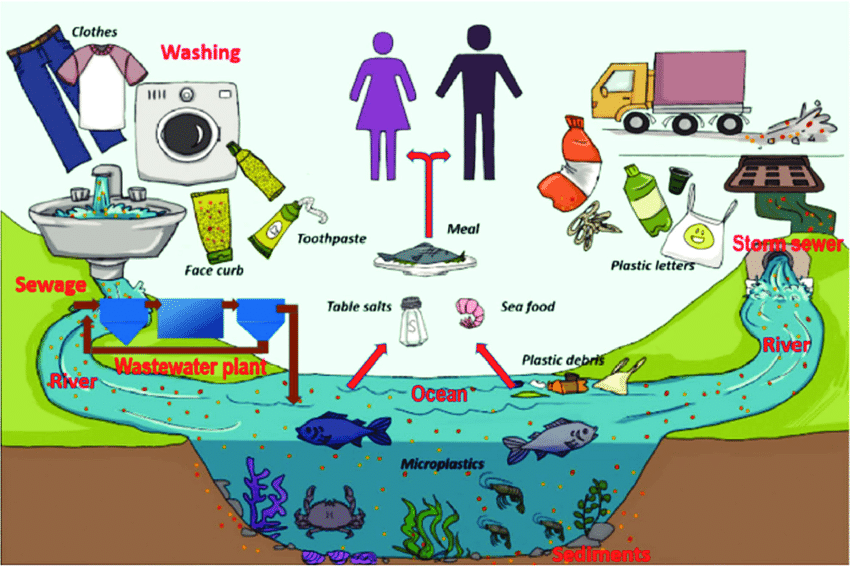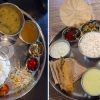Goa is abuzz with excitement as vintage bike and car owners, users, collectors and fans are decking […]

MICROPLASTICS IN OUR FOOD!
Eating is Fun / Eating is Yuck! - A variety food column, Life & Living, Sept 02 - Sept 08 2023 September 1, 2023Microplastic are creeping in our food chain and fat lot we care! If you value your health and the health of mother earth shun all the plastics you can in all the ways you can…. and hurry up about it, there is very little time left to save ourselves from sleepwalking into extinction! There is no nutrition to fuel body beautiful in the plastics of life.
By Tara Narayan
ARE we not scared that increasingly we’ll become sicker and sicker and weaklings dying like flies being swatted out – just because we do not how to safeguard the womb and bosom of the earth (with all its nourishing water bodies)! Just because do not know how live a sustainable life down the rewarding path of the straight and narrow – so that we live at least to enjoy the primary joys of life instead of the hedonistic joys of death?
Every now and again comes a report in the media about how the plastics of our life are piling up here, there and everywhere in urban and remote once pristine places – in villages which once upon a time never knew what “health food” Maggie noodles looked like! I swear to it while trekking up in the Himachal Pradesh mountains of the Himalaya many years ago, a woman with an ailing child tucked at her waist showed me a Maggie noodles packet (quite dated from the local grocery shop) and asking me “Yeh mere bachi ke liye acha hai?” Is this good for my daughter, she is not feeling well and I want to cheer up. I didn’t have the heart to tell her her to chuck the packet.
Increasingly, we’re seeing how our industrialized packaged foods or non-foods are taking over all corners of the globe and the poorer uneducated or semi-educated people thinking they’re eating superior food if they can afford the food in packets arriving from big cities! It’s bad enough that we in our fine cities in our educated wisdom patronize the industrial junk foods of our times to reap chronic ill-health and become victims of the pharmaceutical industry (with the entire mainstream healthcare system living on it)…but the latest trend is we must eat what the poor people of this country eat to be strong and healthy. Namely, millets!
It is true and I will say it again here: the now educated wealthier people are eating jowar and ragi and bajra and the rest of the family of little and large millets and so seductive is the sales promotion that it’s okay of the price of millets has doubled, trebled and quadrupled. The poorer farmers who grow these millets in their farmland are selling their millet crops for a song to middlemen salesmen and woman – and they think they’re better off eating refined rice, refined sugar, refined oil, refined flour!
Naturally, over some years this is reflected in the deteriorating health of the poor and improve health of the rich! As the cheaper wholesome foods they used to eat like millets, jaggery, ghani-pressed oils are purchased by the richer while they survive on cheap rice, white sugar and fusion refined oils…do our departments of health care? If the poor working classes begin to lose their once fighting health status while the rich resting classes eat better qualitatively and go climb the mountains of adventure?
AN UGLY TREND!
IN this respect I always remember arguments between my father from a rock-bottom poor background village household and my mother from a well-to-do British Raj era village household where my maternal grandfather, as a British Rail station master could pretty well afford all the perceived “good food” of the time coming into the early processed food market, for his half-a-dozen children.
Whenever there was an argument on the subject of food my mother would tell off my father: “What do you know! You grew up on bajra rotla, gor (jaggery nuggets) chaach (thin buttermilk), while my father could give us bhakri (of wholesome wheat flour) and cow’s milk with sugar in it!” You see in those times millets like pearl grey or bajra, jaggery nuggets, buttermilk… were perceived as poor people’s food; while rich whole wheat flour, dairy milk, sugar, ghee, were rich people’s food.
Never mind that in the post-independence years the food scenario got more and more vitiated with refinement and industrialisation on one hand, while on the other hand the coutnry’s primary earth or farming soil got poisoned with the large scale use of chemical fertilizers, fungicides, etc, and our primary grains changed out of context and became refined, adulterated and some more tricks of the trade to maximise profits at the expense of basic health of the people. Say the country’s agricultural fields lost their raison d’etre for yielding nutrient-dense food.
Of course a lot more happened down the line of agricultural output and takeover by corporate greed as industrial chemicals killed the wholesome nature of the very soil itself (the womb of the earth) so that even out primary fresh food crops lost their nutrient values – and a host of other things you may read up about like genetically modified crops and control of seeds, etcetera. The end result is today’s revival of organic soil and crops and no GMO foods please – organic agriculture is replacing the chemical agriculture of post-world wars and industrialisation…but the fight is still on weed out big and beautiful but empty of life values from the small, nutritious and full of life values, say the heart and soul of food fit for eating to live and not die prematurely!
We still don’t get it, how what we eat and how we eat defines our immune system and related health parameters. Sure, many local movements are here now to pursue organic farm to dining table philosophy – eat organic, eat local, eat simple. Still, there are far too many high-end lobbies with agendas to divide the world between the few evil-mongers who pursue a healthy longevity at the top of the pyramid of the good life, at the expense of the many who slave away blindly at the bottom rungs….
So the call going out nowadays is wake up, wake up. Eat good food, drink good water, breathe good air – chase good dreams for the many rather than the handful of filthy corporate so called human beings who would like to divide the world between utopia and dystopia, all together a world hinged on divisions reminiscent of caste systems of old but now new in the making! We need to keep the world a level playing field for the many rather than for a few handfuls romancing life in their mould of plenty and pulchritude.
THE GUJARATI DHOKLA!
AND that’s enough food for thought this week! For the entire monsoon season not over with as yet I’ve been dreaming of making the Gujarati piece de resistance of dhokla or as we say in Gujarati – “dhokra.” The Gujarati culinary world of dhokla is something worth familiarizing yourself with if you love steamed food. I’d say dhokla is better than steamed momo (of Tibetan, north-eastern and oriental origins)! Momo have become so successful with commercial chain vendors that now the momo are actually frozen affairs many days old or maybe months old before they’re transported wherever to be unfrozen and served fancily on demand.
Frozen industrial food makes life so much more economically money-saving for it means you may give some employees a fond farewell (regardless of whether they good or bad employees, in many of these chain food retailers employees too suffer from unhygienic practices and logistics become a pain you know where)…
But to stay with the irresistible savoury called dhokla in local parlance the country over, although most will identify it with the state of Gujarat where it was invented in several familiar versions. It is mostly served as breakfast fair or evening early snack. I grew up with my mother making “khatta dhokla” where she usually soaked split chickpeas overnight, the next morning it was ground into a batter and set to ferment with curd…when the batter rose she would add “aadu-leela marcha” (pestle and mortar ground ginger and green chilli) in the batter, turmeric powder, turn around, Eno’s fruit salt and with a quick whirl and a prayer pour the batter into a lightly oiled plate or thali in a steamer or cooker, cover and let it steam cook. Sometimes she would sprinkle some red chilli powder atop it before steaming. When a knife edge or toothpick comes out clean it is cooked, remove and cut into pieces as desired.
You may temper the dhokla in some hot oil adding mustard seeds, curry leaves and asafoetida, slit green chillies…white sesame seeds! Drape it all over the cut piece dhokla before serving.
I generally like my dhokla plain and served with cold-pressed sesame seed oil and fresh green coriander-mind chutney. Of course, there are several varieties of dhokla, some lightweight and some substantial with a bite to savour. The Jain Gujarati community like their “idada” or white dhokla (made of soaked rice and urad dal/black gram batter and thinly cut); some prefer to use the faster gram flour for making “khaman dhokla” or instant dhokla…ladling a spicy sugary watery tempering over it so the dhokla are soaking wet…call them eastern dhokla too if you like, these kind of dhokla crumble in the mouth meltingly.
Dhokla may be white, yellow or ivory and then some enterprising dhokla makers will also turn out beetroot red or spinach green dhokla, cut them into fancy itsy bitsy pieces and serve at uppercrust cocktail parties…
The best dhokla to make is out of soaked lentils batter, or even rava (semolina) or the millet flours. Slightly sour curd lends a delightful sour flavour. Austere plain rava dhokla come with cracked black pepper dotting them. You want to make them extra protein rich scrape in some tofu or paneer, finely chopped veggies if you wish…one of these days I want to do dhokla with chopped dill greens in them!
Considering the popularity of dhokla I’m surprised nobody has started doing an only dhokla retail business (a la momo) – of course most of the Gujarati farsan shops in Ahmedabad and Mumbai suburbs do offer a variety of dhokla, including mini-idli styled ones. Some crazy folk will top dhokla with a medley of crunchies and chutneys to arrive at a dhokla chaat! Enjoy.
This is to say monsoon months are ideal for dhokla eating and in my eyes qualify as health food to go into ecstasies over, but than being a Guju, I am biased, okay.
RECIPE FOR KHAMAN DOKLA
Ingredients:
For Batter:
1 cup Gram Flour (Besan/Chickpea Flour)
1 tablespoon Semolina (rava/sooji), optional
1½ teaspoons Lemon juice
1 teaspoon crushed Green Chilli-Ginger (or paste)
1/4 cup Curd (plain yogurt)
3/4 cup Water
1/2 teaspoon Salt, or to taste
1 teaspoon Eno Fruit Salt
1 teaspoon Oil (for greasing)
For Tempering:
2 tablespoons Oil
1/2 teaspoon Mustard Seeds
1 pinch Asafoetida (hing)
1/2 teaspoon Cumin Seeds (optional)
1 teaspoon Sesame Seeds (til)
10-15 Curry Leaves
4 Green Chillies, slit lengthwise and cut into halves
1/3 cup Water
1 tablespoon Sugar
2 tablespoons chopped Coriander Leaves
2 tablespoons grated Fresh Coconut
Directions For Batter and Khaman Dhokla:
1- Take all ingredients to prepare batter. Pour approx. 2-3 cups water in steamer at bottom and heat it over medium flame. Make sure that steamer is at least 4-5 minutes heated before placing the plates (filled with batter) in it. Grease 2 small plates or thalis (4-5 inch diameter) using 1-teaspoon oil.
2- Take 1 cup gram flour, 1 tablespoon semolina(sooji/rava), 1½ teaspoons lemon juice, 1 teaspoons green chilli-ginger paste, 1/4 cup curd, 3/4 cup water and salt in a bowl. Mix them properly into smooth batter. Make sure that there are no lumps.
3- Add 1 teaspoon fruit salt in batter and stir in one direction for approx. 1 minute. You will notice its size would increase to almost double.
4- Now, pour batter immediately into each greased plate and fill it upto 1/2-inch thickness.
5- Place plates in steamer and steam for 10-12 minutes over medium flame.
6- After 10-12 minutes, insert a knife or toothpick into dhokla and check if it comes out clean. If it does, then it is ready otherwise cook 2-3 minutes more.
7- Takeout plates from steamer and let them cool for few minutes. Cut fluffy khaman dhokla into small squares using knife.
Directions for Tempering:
1- Heat 2 tablespoons oil in a small pan or tempering pan. Add1/2 teaspoon mustard seeds and a pinch of asafoetida (hing). When seeds begin to crackle, add 1/2 teaspoon cumin seeds, 1 teaspoon sesame seeds, 10-15 curry leaves and 4 green chillies. Sauté them for few seconds.
2- Add 1/3 cup water and 1 tablespoon sugar and bring it to a boil; let it cook for a minute over high flame. Tempering(tadka) is ready, pour it over dhoklas and toss gently until each dhokla is coated well with tempering.
3- Garnish with 2 tablespoons chopped coriander leaves and 2 tablespoons grated coconut. Serve with green coriander chutney.















